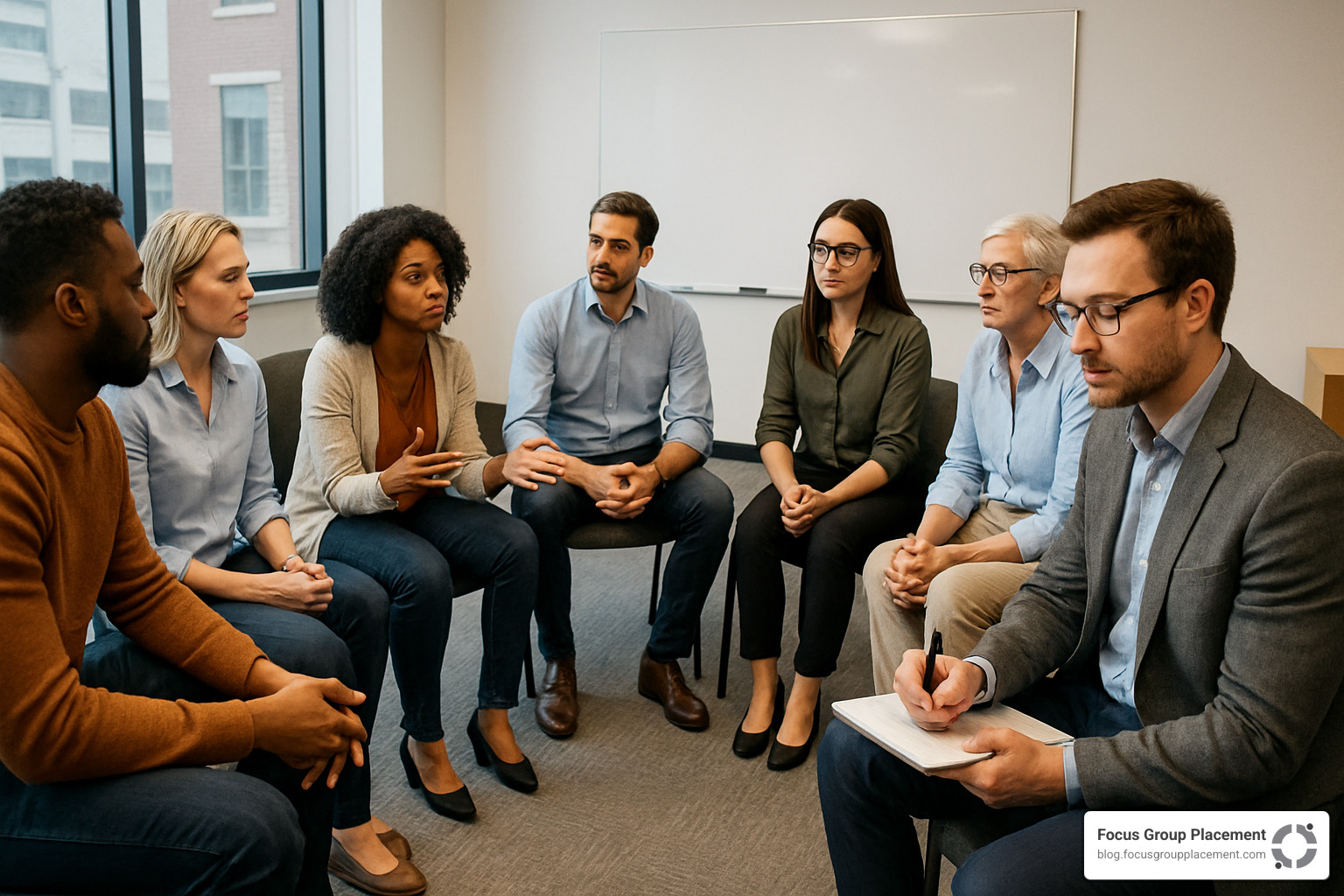Finding Market Research Firms Near You: A Complete Guide
If you’re looking for market research firms near me, here’s a quick guide to find the best options in your area:
- Use Google Maps – Search “market research firms” and filter by your location
- Check industry directories – Greenbook, Quirk’s, and ESOMAR offer searchable databases
- Ask for recommendations – Local business networks and chambers of commerce often have lists
- Visit FocusGroupPlacement.com – Our directory includes verified local research partners
Market research firms help businesses understand their customers and make data-driven decisions. When searching for market research firms near me, you’re looking for partners who can provide valuable consumer insights through surveys, focus groups, interviews, and data analysis.
Local market research companies offer several advantages over national firms. They understand your regional market, can arrange in-person sessions more easily, and often deliver results faster with more personalized service. According to our research, 96% of clients who work with local firms recommend their services to others.
Working with a nearby research partner means you can visit facilities in person, meet face-to-face with consultants, tap into local consumer panels, and get insights that account for regional preferences and behaviors.
I’m Scott Brown, founder of Focus Group Placement and an expert in connecting businesses with market research firms near me through our suite of online survey communities and research directories.

Why Partner With Local Market Research Firms Near Me?

There’s something incredibly valuable about working with someone who truly knows your neighborhood. When you partner with market research firms near me, you’re gaining access to insights that national companies simply can’t match – the kind that come from living and breathing your local market every day.
Cultural Nuance and Regional Understanding
Your local customers have unique preferences that often fly under the radar of big national studies. Take the fascinating case from New Jersey, where a Freedonia study found that most people only reuse their “reusable” bags two or three times before tossing them – crucial information for retailers adapting to the state’s plastic bag ban.
As one industry expert from SIS International Research told me, “Without feedback from local experts and consumers, it’s unlikely to develop an effective strategy for new markets.”
Faster Turnaround and Real-Time Collaboration
When your research partner is just across town instead of across the country, everything moves faster. Local firms don’t waste time with travel logistics or navigating unfamiliar territory – they already have established community panels and know exactly where to find your target audience.
In-Person Collaboration Advantages
There’s real magic that happens when you can sit across the table from your research team or watch a focus group through a one-way mirror. These face-to-face interactions create deeper understanding and stronger partnerships.
When you work with market research firms near me, you can observe research sessions in real time and have immediate debrief conversations after important findings emerge.
Community Connections and Recruitment Advantages
Local research firms have spent years building relationships in your community. This means they can find exactly the right participants for your studies – even if you’re targeting a super-specific demographic.
This local focus often reveals golden opportunities that broader studies miss. Scientific research on local consumer trends backs this up. For instance, the snow blower market grew from $400 million in 2019 to $508 million in 2024 – information that would be crucial for businesses in snowy regions but might get diluted in national data.
Local vs. National vs. Global—Which Delivers the Best ROI?
I often help clients think through this exact question. Here’s how the options typically stack up:
| Factor | Local Firms | National Firms | Global Firms |
|---|---|---|---|
| Cost | $ – $$ | $$ – $$$ | $$$ – $$$$ |
| Speed | Fast (1-4 weeks) | Moderate (3-8 weeks) | Slower (6-12+ weeks) |
| Regional Expertise | Exceptional | Varies | Limited |
| Methodology Range | Moderate | Extensive | Comprehensive |
| Personal Support | High-touch | Moderate | Often tiered |
For most businesses I work with, local firms hit that sweet spot of value – delivering meaningful insights without the hefty price tag of larger organizations.
How to Find and Vet Market Research Firms Near Me

Finding that perfect local research partner doesn’t have to feel like searching for a needle in a haystack. With a bit of strategy and some insider knowledge, you can connect with market research firms near me that truly understand your business needs.
Online Directories and Professional Associations
The research world has several go-to resources that make finding local experts much easier. The Greenbook Directory has long been the industry gold standard, letting you filter firms by both specialty and location. The Quirk’s Directory gives you detailed profiles of each company’s personality and approach.
For those who value ethical standards, the ESOMAR Directory maintains strict requirements for listed firms. Don’t overlook your local American Marketing Association (AMA) chapter either – they often maintain curated lists of respected research partners in your area.
The Marketing Research Association (MRA) can connect you with certified professionals who’ve demonstrated their expertise. And your local Chamber of Commerce likely has relationships with specialized research providers who understand your community inside and out.
Word-of-Mouth Referrals
Nothing beats a trusted recommendation when it comes to finding research partners. Reach out to fellow business owners who’ve faced similar challenges – they’re usually happy to share their experiences, both good and bad.
Industry association colleagues can offer particularly valuable insights, as they understand the unique research needs in your field. Marketing agencies you’ve worked with often have established relationships with reliable research firms.
“Market Research Firms Near Me” Search Hacks
When you’re turning to Google to find local research partners, a few simple techniques can dramatically improve your results. Try adding your neighborhood, city, or county name to make your searches more targeted. Google Maps is particularly useful here, as you can filter results by both proximity and customer ratings.
Looking for firms with real experience in your industry? Try searching for “[Your Industry] market research case study [Your City]” to find specialists with proven results.
Pay attention to a firm’s social media presence too. Active, engaged local accounts usually indicate companies that are well-connected in your community.
8 Questions to Ask Before Signing a Contract
Once you’ve identified promising market research firms near me, it’s time for a deeper evaluation. Here are the essential questions that separate the exceptional from the merely adequate:
-
What is your industry expertise? A firm that’s worked extensively in your field will hit the ground running.
-
Do your research methodologies align with my needs? If you need to understand the “why” behind consumer behavior, a firm that specializes only in large quantitative surveys might not be your best match.
-
How transparent are you about your processes? Quality partners will openly share how they collect data, recruit participants, and analyze findings.
-
What are your typical timelines? The best research is thoughtful and thorough, but it should also match your decision-making schedule.
-
What is your cost structure? Ask what’s included in the base price versus what might be added later.
-
What data security measures do you have in place? This is particularly crucial if you’re in healthcare, financial services, or other sensitive industries.
-
Can you provide anonymized examples from previous local projects? These demonstrate not just capability but also their understanding of regional nuances.
-
What post-project support do you offer? The best partners help you implement insights, not just collect data.
Red Flags to Avoid
While searching for market research firms near me, watch for warning signs that could save you from a disappointing partnership:
- Opaque pricing often hides inflated costs or indicates inexperience with project scoping
- Outdated methodologies that don’t reflect current best practices
- Slow communication speed during the proposal process
- Cookie-cutter approaches that don’t account for your unique business needs
- Reluctance to provide client references
- Claiming local expertise without an actual local presence
- Guaranteed outcomes that sound too good to be true
Top Service Categories Offered by Local Legends

When you’re searching for market research firms near me, you’ll find that local research partners offer an impressive range of services. Think of these local legends as your neighborhood insight specialists – they’re equipped with tools to answer just about any business question you might have.
Qualitative Deep Dive
Nothing beats the richness of qualitative research when you need to understand the “why” behind consumer behavior. This is where local firms truly shine!
Focus groups bring together 6-8 carefully selected participants for guided conversations about your products or services. These sessions typically run 1-2 hours, with participants receiving $50-$200 for their time and thoughts.
When you need to explore sensitive topics or dive deeper with individuals, in-depth interviews (IDIs) are invaluable. These one-on-one conversations eliminate peer pressure and allow people to open up in ways they might not in a group setting.
Want to see how people actually use your product in real life? Ethnographic research takes researchers into natural environments to observe authentic behaviors. Local researchers can easily visit multiple locations across your market area, capturing photos and videos that tell the real story.
Many local firms also offer facility rental options, including professional focus group rooms with recording equipment, test kitchens for food research, mock retail environments, and comfortable interview spaces.
Quantitative & Analytics Powerhouse
When you need hard numbers to back up your business decisions, quantitative research delivers. Local firms bring statistical rigor with a personal touch.
Survey research helps you measure opinions across larger groups, typically ranging from 200-2,000+ respondents. Your neighborhood research partner likely maintains regional consumer panels that make recruitment faster and more targeted.
Need to make sense of complex data? Statistical modeling identifies patterns and correlations that might otherwise remain hidden. From market segmentation to predictive analytics, local analysts can translate numbers into actionable business insights.
Modern dashboard & visualization tools have transformed how we interact with research data. Rather than dusty reports that sit on shelves, today’s local firms offer interactive platforms where you can explore findings in real-time.
For businesses with tighter budgets, many local firms offer access to syndicated data – pre-existing research that covers your market area.
Industry-Specific Specializations Near You
One of the most valuable aspects of working with market research firms near me is their deep understanding of industries that dominate your regional economy.
In healthcare & medical markets, local firms conduct everything from patient experience studies to healthcare provider research. They know the regional healthcare systems and can steer the complexities of medical research with expertise.
For technology & software companies, local researchers offer usability testing with real users from your target market. They can recruit beta testers, conduct UX research, and help you understand tech adoption patterns specific to your region.
Retail & consumer packaged goods businesses benefit from mystery shopping programs and in-store experience evaluations. A local firm can tell you exactly how your products perform on local shelves compared to competitors.
In the financial services sector, local researchers understand regional banking preferences, investment behaviors, and insurance needs. They can help you tailor your offerings to local financial realities.
And for tourism & hospitality businesses, nothing beats local knowledge. From visitor experience tracking to destination marketing research, regional firms understand what brings people to your area and what keeps them coming back.
By partnering with a local research legend, you’ll gain insights that national firms simply can’t match – delivered by people who understand your market because they live and work there too.
Costs, Timelines & Proven Success Stories

When you’re searching for market research firms near me, understanding the investment required helps you plan effectively. Let’s break down what you can expect to pay, how long things take, and share some inspiring success stories.
How Much Should You Budget?
The cost of market research varies widely based on what you need. For focus groups, expect to invest between $4,000-$8,000 per group. This typically covers recruiting participants, professional moderation, facility rental, and basic analysis of findings. Mini-groups with 4-5 participants might run $3,000-$5,000, while online focus groups can save you about 20-30% compared to in-person sessions.
In-depth interviews typically range from $300-$600 each for consumer interviews, while professional or B2B interviews run higher at $500-$1,000 per interview. Most firms offer volume discounts for multiple interviews.
For surveys, online consumer research typically costs between $5,000-$15,000, depending on length and sample size. B2B surveys cost more ($8,000-$25,000) because finding the right professional participants is more challenging.
Many local research partners offer flexible ways to work together:
- Project-Based: One-time studies with clear deliverables and timelines
- Retainer: Ongoing relationship with a set monthly fee
- À la Carte: Individual services purchased as needed
- Subscription: Access to syndicated research or data platforms
Working with a tight budget? Consider looking into grant programs, SBA resources, university partnerships, or omnibus surveys (where you add your questions to a larger survey to share costs with other businesses). The Small Business Administration provides excellent market research guidance and sometimes financial assistance to help you get started.
Speed to Insight—What’s Realistic?
For quick-turn projects, online surveys using existing panels can deliver results in 1-2 weeks. Focus groups in major markets might take 2-3 weeks to recruit and conduct, while rapid ethnographic site visits typically need 2-3 weeks from start to finish.
Standard timeline projects require more patience. Comprehensive survey research usually takes 4-6 weeks from questionnaire design to final report. If you’re running focus groups across multiple cities, plan for 4-8 weeks. Mixed-method studies combining different research approaches typically need 6-10 weeks to complete properly.
The good news? Local firms often move faster because they have established local participant panels, less travel time for field research, more flexible scheduling for in-person methods, and better relationships with local facility providers.

Local Case Study Hall of Fame
These real-world examples show how local research firms have delivered meaningful results for businesses just like yours:
A professional sports team was struggling with fan satisfaction scores. They partnered with a local research firm to dig deeper through in-stadium intercepts, online surveys, and focus groups with season ticket holders. The research pinpointed specific pain points in concessions and entry experiences. After implementing changes based on these findings, fan satisfaction jumped 22% and concession revenue increased by 15%.
A regional convenience store chain needed to improve their mobile ordering app but couldn’t figure out why customers abandoned their carts. Through careful usability testing with actual customers both in-store and at home, their local research partner identified critical friction points in the checkout process. The redesigned app increased mobile order completion rates by 34% and average order value by 12%.
In the financial services sector, a wealth management firm was struggling to connect with multiple generations within family units. Their local research partner conducted in-depth interviews with grandparents, parents, and adult children to understand different perspectives on wealth transfer. The resulting family financial planning framework became a cornerstone of the firm’s client engagement strategy and helped them retain 87% of assets during intergenerational transfers, well above industry averages.
Whether you’re launching a new product, improving customer experience, or trying to understand changing consumer behavior, market research firms near me can provide the insights you need to make confident, data-driven decisions. The investment pays for itself many times over when you avoid costly mistakes and identify opportunities you might otherwise miss.
Frequently Asked Questions About Market Research Firms Near Me
What industries do nearby firms specialize in?
When you’re looking for market research firms near me, you’ll find that many local agencies develop expertise in industries that thrive in their region. It’s a natural evolution—firms become specialists in what surrounds them.
For instance, if you’re in Boston or Minneapolis, local research partners often excel in healthcare and pharmaceutical studies. These firms understand the complex regulations and unique challenges facing medical companies because they’ve worked with them for years.
In tech hubs like San Francisco or Seattle, you’ll find research companies that speak the language of software developers and understand user experience testing inside and out. They’ve likely helped dozens of startups refine their products before launch.
Manufacturing-heavy regions tend to produce research firms with strong B2B capabilities and deep knowledge of industrial processes. Meanwhile, in places where tourism drives the economy, you’ll find experts in visitor experience and hospitality research.
The beauty of working with a local specialist is their contextual understanding. They don’t just know research methods—they understand your industry’s specific challenges, competitive landscape, and regulatory environment.
Can local agencies handle both B2B and B2C projects?
Yes! Many local research firms skillfully steer both business-to-business and business-to-consumer projects, though some may have a stronger track record in one area.
B2B and B2C research require different approaches. B2B studies typically involve smaller but harder-to-recruit sample sizes. These projects generally require higher participant incentives, longer interviews, and researchers who understand complex decision-making processes involving multiple stakeholders.
In contrast, B2C research usually features larger sample sizes that are easier to recruit. These studies focus more on emotional drivers and psychological factors, with broader demographic targeting and more consumer-friendly research instruments.
When considering a local firm for B2B work, ask specific questions about their professional respondent database, their experience mapping complex purchase journeys, and their ability to recruit hard-to-reach decision-makers.
How do local firms ensure data accuracy?
Quality research is built on accurate data—it’s the foundation everything else stands upon. Reputable local research firms employ multiple safeguards to ensure what they’re collecting is reliable and representative.
For participant verification, good firms don’t just take people at their word. They verify IDs for in-person studies, use digital verification techniques for online research, cross-check demographic information, and screen for “professional respondents” who might participate in too many studies and skew your results.
The best local partners build quality control directly into their research design. They include attention checks in surveys to catch people who are clicking randomly, monitor for speeding through questionnaires, record qualitative sessions for review, and sometimes use multiple moderators to reduce potential bias.
Statistical rigor is another hallmark of quality research. This includes appropriate sample sizing to ensure statistical significance, weighting data to match population demographics, transparently reporting margins of error, and using multiple analytical approaches to validate findings.
The best market research firms near me won’t just promise quality—they’ll explain exactly how they deliver it, step by step.
Conclusion
Finding the right market research firms near me isn’t just about proximity—it’s about finding a partner who truly understands your local market and can deliver insights that make a real difference to your business.
Throughout this guide, we’ve explored how local research partners offer advantages that national or global firms simply can’t match. When you work with a researcher who lives and works in your community, you gain someone who inherently understands the regional nuances that shape consumer behavior in your area.
Beyond just better insights, local partnerships offer practical benefits too. Your research projects can move faster when you’re not dealing with time zone differences or travel logistics. There’s something invaluable about being able to sit face-to-face with your research team, observe focus groups in person, or quickly pop by their office when questions arise.
Remember to take your time when vetting potential research partners. Those eight key questions we outlined earlier—about industry expertise, methodologies, data transparency, timelines, costs, data security, case studies, and ongoing support—can save you from partnerships that don’t deliver value.
Whether you need deep qualitative insights from focus groups, robust quantitative data from surveys, or specialized industry knowledge, there are excellent local options in most markets. The investment in quality research typically pays dividends many times over through better business decisions, reduced risk, and identified opportunities.
At FocusGroupPlacement.com, we’re passionate about connecting businesses with quality research opportunities across the country. Our nationwide network includes verified research partners in over 200 cities, making it simple to find the right match for your specific needs.
Ready to begin your search for market research firms near me? Visit our directory.









































